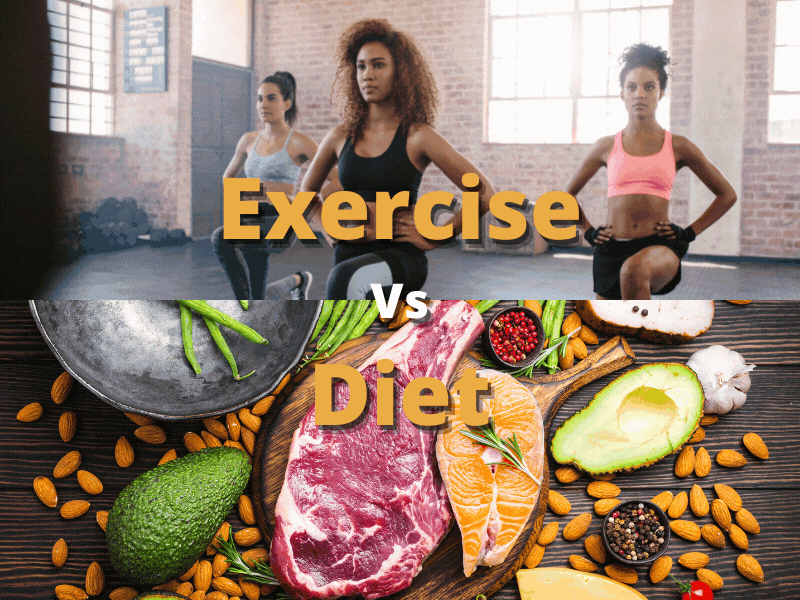When I was 20 years old, I weighed about 165 lbs and thought I was too skinny. I tried eating a diet higher in fat and found that it didn’t help me gain weight. My body didn’t process food in a way that helped me gain weight but helped me maintain my current weight.
Diet and exercise are both important in maintaining a healthy body. Diet provides essential nutrients and exercise provides essential movement. The secret of success (for your health) is to know your body, to understand how foods and exercise helps, and to be consistent.
Now that I am about 180 lbs and 47 years old, I can see how my diet and exercise play a vital role in how my body operates to control weight, mood, genetics, and overall health.
Past Vs Now
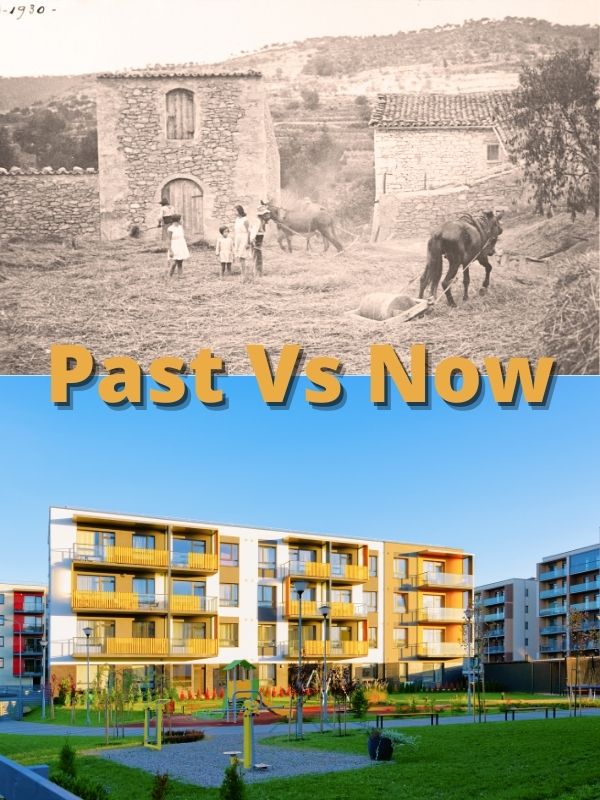
In the Past
It has been a topic of conversation and contention for hundreds of years. In the past, people didn’t have the variety of foods we have access to today. If you were a farmer you’d eat what you grew and what you could trade for in town.
People were involved in physical labor much more and ate less variety. Diseases were less treatable, so people in the 1860s in the United States had about a life expectancy of 39.4 years. (statista.com)
After 1880 life expectancy in the US rose fairly consistently until now where the life expectancy is about twice what it was before at 78.81. (statista.com)
So what was the secret of doubling our life span? Mostly it was from medical advancements and people living in better conditions with more access to the conveniences of water, sanitation, and food.
Cleaner conditions, eating healthier, and less stress on the body from hard labor made a big difference for the general population.
Success Secret 1 – The quality and cleanliness of the food we eat each day can put years into our life span. Eating more nutritious food that is grown, packaged, and cooked well helps us live a healthy and happy life.
Now
Today, we can live a healthy life up to 80+ years. But we do have lots of challenges we face. “Heart disease is the leading cause of death for men, women, and people of most racial and ethnic groups in the United States.” (cdc.gov)
Inside Life
Most people live their lives inside rather than outside. Whether it’s inside the home, work, or store, we often only get outside once in a while. This living inside most of the time allows people to gravitate towards physical inactivity.
That’s why so many people join the gym because they really feel the need to exercise. They don’t have to do much of any physical labor most of the day, so they don’t get a chance to move the way the body needs to move.
Sitting down is a constant for many American lives. We sit to work, for entertainment, and many hobbies. Inside life is a very convenient way to live that has helped us live healthier lives, yet our bodies are meant to move, and being sedentary leads to many health problems.
Convenient Food
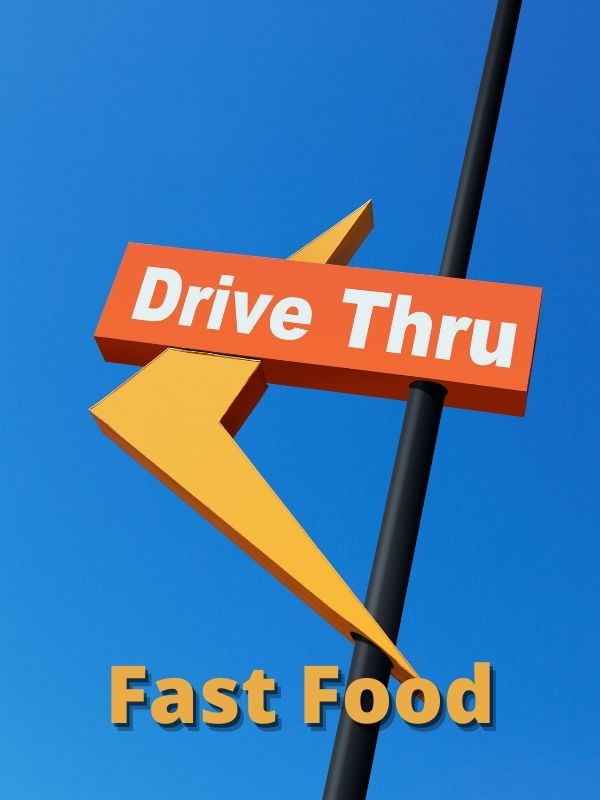
When it comes time to eat, many people choose a fast food restaurant to save time at breakfast, lunch, and dinner. In the United States, we have a work culture. We are always busy working because we don’t get much time off.
Other countries try to balance work and personal time by giving their people mandatory time off. As you can see on the map below the United State has no mandatory days off.
Map of minimum mandatory vacation days around the world. Here are the vacation days by color:
Map of minimum mandatory vacation days around the world. No data No mandatory vacation 1–5 days 6–10 days 11–15 days 16–20 days 21–22 days 23–28 days
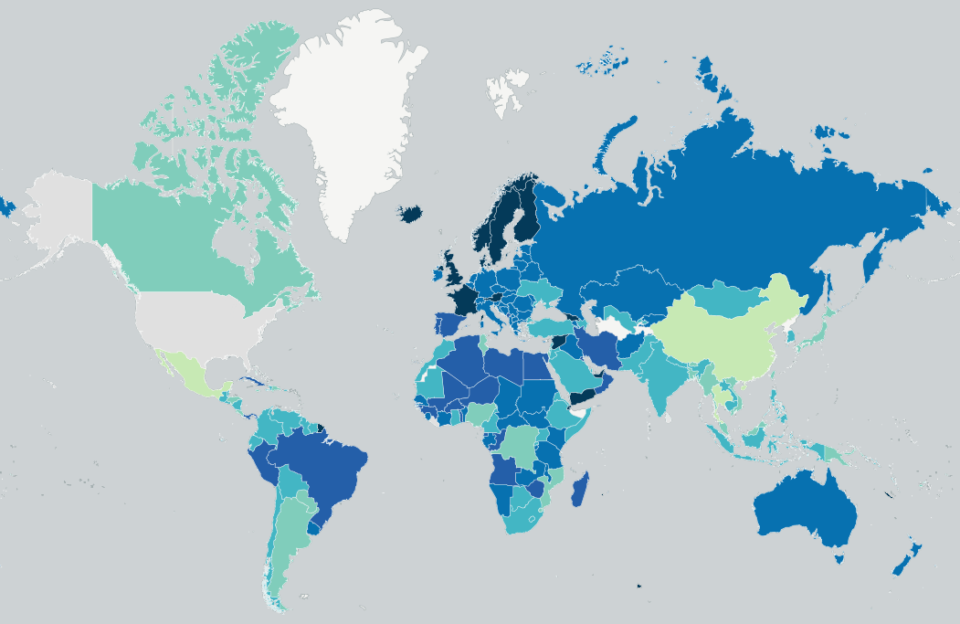
Our work culture and many varieties of fast-food restaurants make it easy to save time and get something on the way to work or on the way home. More families have two parents working to make ends meet, so time to cook is limited. Instant food has been a solution that many people look toward to make life a bit easier.
Success Secret 2– Less stress and more physical activity will aid in preventing disease and maintaining healthy body functions. Spending time buying whole foods and preparing them to eat will add years to our life and our health.
Effects of Exercise and Diet

If we sit all day and eat healthy our body can maintain our health only up to a certain point. The same goes for exercising five times a week for 45 minutes and eating fast food every night. We need to use both exercise and diet to get the most out of our health.
There are many factors to consider when we want to get healthier. Let’s take a look at how exercise and diet compare in various areas.
Effects of Exercise
Genetics – Science has shown that exercise can change the way our body works. Exercise changes how the body works, benefiting our health.
Effects of Diet
Genetics – What we eat can help to change our bodies, just like exercise can. Our epigenetic expresses differently, giving us various health benefits.
Consistency – Study after study has shown that people who exercise consistently, even just walking every day, show improvement in their health. Moving consistently improves health.
Consistency – Eating is one of the most important factors in losing weight, even more than exercise. Most people lose weight when they have established a consistently healthy diet.
Calories – We burn calories each day whether we exercise or not. Exercise helps burn calories but may not be as useful as diet when it comes to losing weight. (Although you can lose weight with exercise over many months)
Calories – Diet plays a very important role in our weight. It may be useful to find a satisfying diet that fills you up but has fewer calories. Looking at labels and trying new food can help expand ways to eat healthily and get only the calories you need.
Fat – We can burn fat as we exercise, and increase muscle mass. This helps burn a bit more calories and can increase our metabolism over time.
Fat – We can burn fat as we exercise, and increase muscle mass. This helps burn a bit more calories and can increase our metabolism over time.
Metabolism – All the cells in your body need to use energy. They change sugars into energy. This is called metabolism. Exercise helps use more energy but doesn’t change the speed of your natural metabolism unless you exercise enough that your genetic expression changes.
Metabolism – Your body uses energy to process food. What you eat can influence body composition and how your genetics are expressed. These factors can influence the speed at which you burn calories.
Digestion – When we exercise we stop the digestive process temporarily. If our stomach is empty exercise helps the body process food by moving it, preventing gas and heartburn, and “strengthen your digestive tract…” (russellhavranekmd.com)
Digestion – What you eat has a direct influence on your stomach’s microorganisms. Hydration is also important. A healthy gut can help with dopamine production, the immune system, digestion, cognition, and memory. (ncbi.nlm.nih.gov)
Muscle – Our muscle mass is directly influenced by exercise. (After about 8 weeks of a regular routine we start to see a difference.) How we exercise determines how muscles are made. (Slow twitch and fast-twitch muscles) Slow-twitch burns more calories.
Muscle – Eating healthy influences muscle development and maintenance. A balanced diet with animal or plant protein can both help you gain muscle or maintain it.
Brain – More blood to the brain helps with brain cell growth, improved mood, lowers stress hormones, and maintains cognitive health. Exercise has been said to be just as effective as antidepressant drugs. .
Brain – Eating healthy foods can protect and enhance brain function. “Studies have compared “traditional” diets, like the Mediterranean diet and the traditional Japanese diet, to a typical “Western” diet and have shown that the risk of depression is 25% to 35% lower in those who eat a traditional diet.” (health.harvard.edu/)
Bones – Exercise generally increases bone density, helping provide a strong structure for the muscles and body to use. Exercise also helps improve balance and coordination. All of these things together help prevent broken bones.
Bones – Eating a diet of fish, fruits, and vegetables helps your bones obtain nutrients, like calcium, for healthy structure and density.
Lungs – Lung capacity increases as you exercise regularly. It can continue to increase with more training and this allows more oxygen to enter the bloodstream. You “are better able to perform the tasks of daily living and you feel better in mind and body.” (lung.org/)
Lungs – Foods like fruits and vegetables are generally helpful for the lungs. Grains, dairy, and beans can also be helpful. Alcohol and processed meats should are not helpful.
Heart – Exercise helps our heart get stronger. A stronger heart works more efficiently while we are resting or exercising.
Heart – Diet plays a vital role in heart health. The food we eat can cause plaque to build up in our arteries. Eating healthy can prevent and sometimes reverse the levels of plaque in our arteries.
Success Secret 3 – Exercising some each day gets the body functioning properly. It can be as simple as walking for 30 minutes. Exercise helps our body work better so we feel and function better as a living organism.
Success Secret 4 – Our diet provides essential nutrients for healthy body functioning. Eating unprocessed foods and reducing sugar and fat helps our body not have to work so hard, and we get the vitamins and minerals we need for proper cellular function.
Exercise Vs Diet
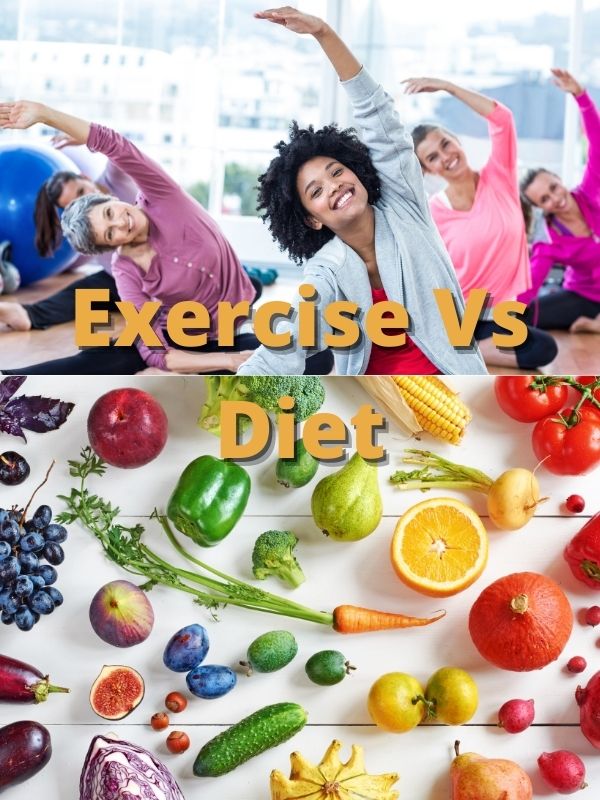
So, now that we’ve talked about exercise and diet, which is better for you to focus on for your health? If I only had one choice, I would focus on diet. Even if I were fairly sedentary, I could live a healthier life for quite a while by eating healthy food.
Our immune system and levels of neurotransmitters are affected by the foods we eat. Our stomach plays an important role in our mood and how we feel.
We can change levels of healthy gut bacteria by eating healthier food, thus improving our overall well-being. Exercise remains important, but if I had only one choice I would choose diet.
A healthy diet puts little stress on the body. Unhealthy foods tax your body quite a bit. Even if I exercise to help me deal with the effect of unhealthy food, eventually my body will start to show and feel the effect of a consistently unhealthy diet.
If you want to just focus on one over the other, I personally would suggest choose your diet and then make exercise a second focus. Once you have established better eating habits, you can then work on creating an exercise routine that works best for your lifestyle.
Both exercise and diet are vital to our health. So taking time to incorporate them into our daily life will pay off in months and years to come.
The key to getting started on our diet and or exercise is to take on bite-sized chunks that we can make a part of our life. Little by little, we can make changes for the better.
As time goes on we will be able to handle more changes easily because we didn’t take on too much at one time.
The only time I would make big changes is when a doctor tells you your life is in danger if you don’t change. Then I would get support from family and friends. I would focus more time and effort on my diet and exercise and less on work or personal interests.
Success Secret 5 – Our diet is likely more important for most people to focus on. Establishing healthy eating habits that can last a lifetime will payout over time.
Once we have good eating habits we can focus more on exercise to maximize our health benefits.
Exercise and Diet Mindset
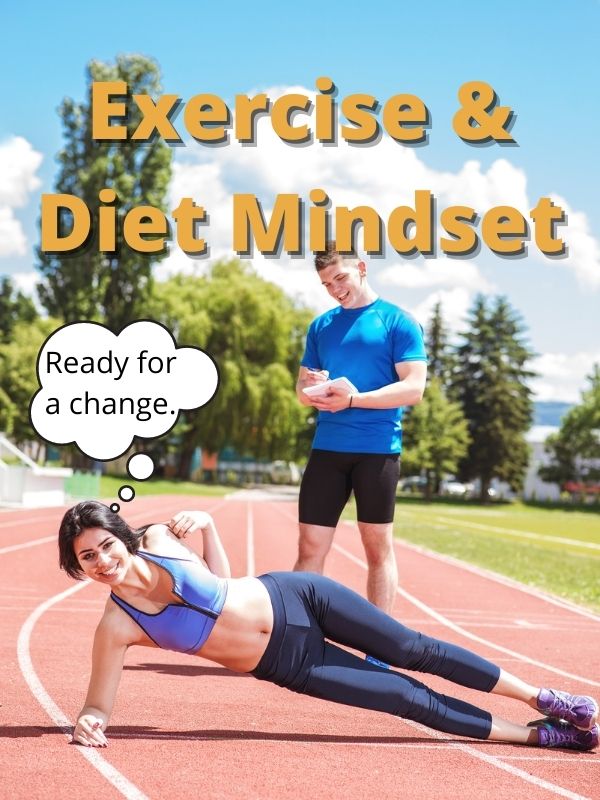
Once we start to go on a diet or exercise there are several mindsets we can adopt. Those who are successful accept that this change in their life doesn’t have an end date, it’s now a part of who they are.
Mindset – Dictionary definition – “the established set of attitudes held by someone.” Here are three mindsets that people often adopt when starting an exercise and diet plan.
1. The Goal Mindset –

Many people set a goal to accomplish an exercise and or diet plan. They work hard and follow their plan and finally, after much work, finish their goal. They tend to lose weight and feel better, but only a small percentage of people continue to work on a diet and exercise plan since they’ve accomplished their initial goal.
They then lose the motivation to continue to exercise. It was difficult to begin with and continues to puts a drain on their emotional energy. Eventually, they just don’t feel they can go on. They need a break and this lead to many people
“By some estimates, 80% of people who successfully lose at least 10% of their body weight will gradually regain it to end up as large or even larger than they were before they went on a diet.”(webmd.com)
So, why do we fail when setting goals?
Their old lifestyle is too comfortable. They were never fully accepting that this change in diet and exercise was permanent. It takes a change of attitude to accept that their old lifestyle is not something they are going to go back to.
No plan for the future. Somewhere in the process of exercise and diet, they said to themselves I can make it to this point, and then no other plan was made.
Too much mental effort. Their mental efforts were focused on abstaining from food and pushing themselves to exercise. They never accepted it as a norm for the rest of their life.
Too much change. Slow and steady changes are easier to accept into our lives and can be sustained over time. Big changes require a lot of sacrifices that most people in their normal daily routine don’t have the support needed to continue forward for long periods.
Success Secret 6 – We should set realistic goals that we can reasonably accomplish in terms of years or the rest of our life, not just a few months. It’s a lifestyle goal and less of a set date goal. (Example – I will eat two fruits a day from now on) (Example – I will set aside exercise time each day)
2. The Gym Mindset –
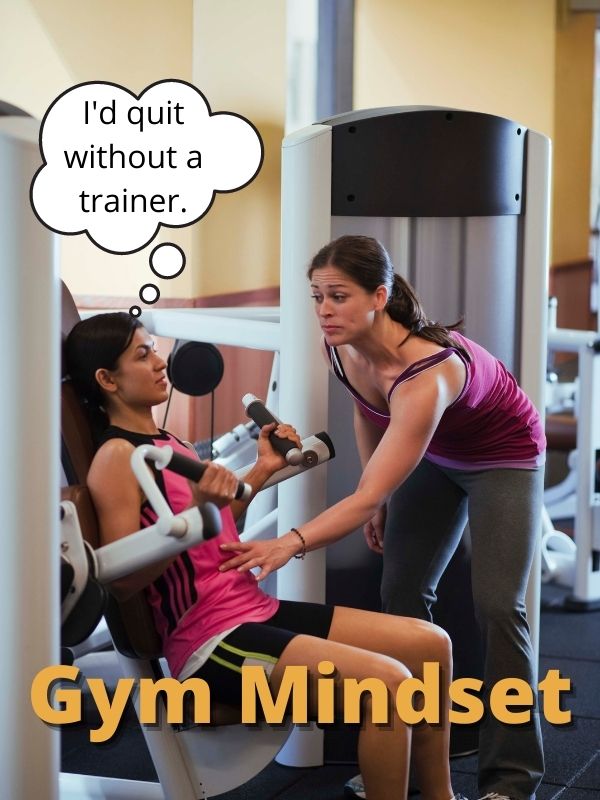
Many people set a goal to go to the gym and rely on their visits to the gym to help them get fit. They may work hard and go to the gym each week and start to see results.
Yet, when life happens, they get busy and stop going to the gym. They have no other backup plan and fail to exercise regularly.
Their initial motivation may be less than it was at the beginning, especially with those who have a heavy work schedule or more things occupying their time. Diet may or may not be a part of the plan, so the food we eat changes as we stop using the gym.
“Despite the expense it is thought that around 80 per cent of Americans who have a gym membership do not use the gym…” (realbuzz.com)
So, why isn’t the gym effective for many people?
Time and effort. Many people find it difficult to find the time and or mental effort to go to the gym with a busy schedule. They feel the need to decompress and relax at home.
They don’t have health goals. Working out is great to help you tone, get a cardio workout, and increase muscle mass. Yet, those who go to the gym are usually focused on their looking better, dating, socializing, using the unique gym equipment/facilities, and sometimes getting healthy.
Too much money. People who join a gym with lower incomes tend to work out less than those with higher incomes. If people aren’t seeing results, they may decide they are just wasting their money at the gym.
Not enough Support. If you go to the gym by yourself, it may be exciting to go at first. After a while, you may start to feel alone. If you feel like you are working hard but you need support to continue going, then you may decide to stop going to the gym.
Success Secret 7 – We need to know ourselves and set specific goals at the gym for how we want to improve our health and get the support we need.
Realistic goals are important. (Example – I will at least go to the gym even if I don’t exercise to form a habit) (Example – I will get a trainer to review goals with me every two weeks.)
3. The Time Mindset –
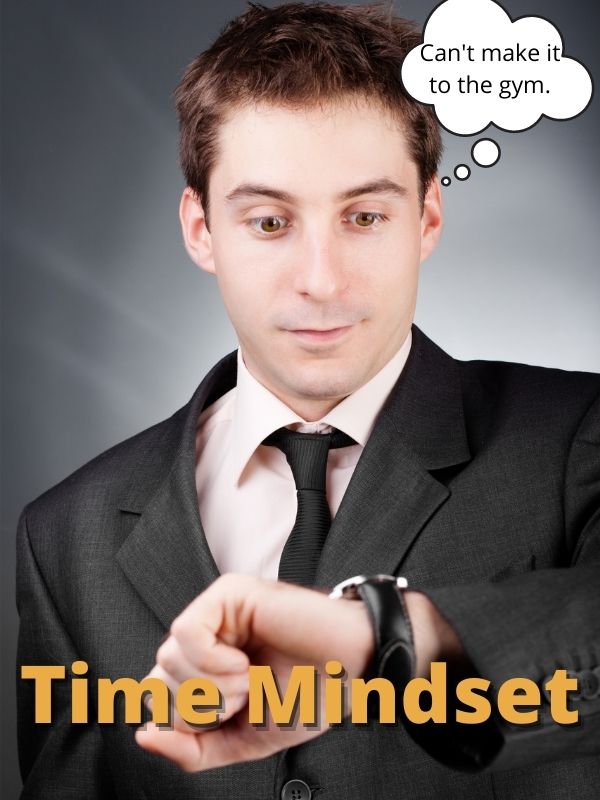
Many people want to get healthy and change their eating habits. Yet, they never set a specific time aside to exercise consistently. They set goals to exercise and eat right, but other priorities take all their time. They may feel there’s no time.
People who feel their time is limited let whatever happens in their life make the choices for them, instead of choosing for themselves. These people can be very active but lack the consistency to adopt a healthy lifestyle.
If their exercise isn’t fun or rewarding somehow, it may not be as important a priority as so many other things are competing for their time.
So why don’t people set time aside to work on their exercise and diet goals?
Gravity. Many people find themselves prioritizing everything else over exercise and diet. Work, relationships, and friends pull on them for their time until they don’t have any left to exercise or take the time to prepare healthy meals.
Importance. We place a value on people, places, activities, and things. Exercise is sometimes given a low value. After some introspection, we may place a high value on exercise and diet at the beginning of the year.
Later the value of exercise and diet doesn’t seem so high.
We can’t see the future. It’s hard to tell people to buy and hold in the stock market for several decades when it fluctuates so often, even though those that do most always get rewarded with high returns.
Like the stock market, we want to see the result of our efforts as soon as possible and can’t seem to wait and invest time each day for years to get a good payoff.
Addiction. We may have the time to exercise, but we are unwilling to give up so much of our time on things we feel we can’t live without. If we let them go, we might feel overwhelmed.
Here are some things people might have an addiction to: TV, internet, phone, shopping, eating, sex, work, and gambling. Whatever the addiction, we may need help breaking away and setting time to exercise and eat healthily.
Success Secret 8 – Setting aside time is usually the only way some people can exercise. That may mean getting up an hour earlier.
Make time in your day to exercise and eat right. (Example – I will spend 15 minutes in the morning preparing a healthy lunch for work. ) (Example – I will get an under-desk elliptical to use at work.)
Adopting an Acceptance Mindset

If we are to adopt a healthy mindset for exercise and diet, we need to be willing to accept the goals we have for our health into a lifestyle that we can reasonably live with them each day.
Each new exercise or diet change that occurs should be sustainable so we can integrate it into our daily life.
Some people do great in setting goals and accomplishing them, but never accept their diets and exercise as a lifestyle. Maybe for some, it’s all a little too fast and too much. So preparing and getting ready can be helpful.
Like bringing a child into the world, we need to accept our diet and exercise and bring it into our lives in a healthy manner.
We can learn little by little how to bring a bit more exercise and healthy eating into our lives and not get overwhelmed. Taking time out to spend with it and care for it daily, like a child.
Eventually, it will be a part of a sustainable lifestyle we can live without feeling the need to give up.
Thanks for visiting Helpshoe.com
References
https://www.mayoclinic.org/healthy-lifestyle/weight-loss/in-depth/metabolism/art-20046508
https://barmethod.com/fun-facts-about-how-exercise-changes-your-muscles/
(Update: Website not available)
https://russellhavranekmd.com/exercise/
https://www.ncbi.nlm.nih.gov/pmc/articles/PMC4259177/
https://orthoinfo.aaos.org/en/staying-healthy/exercise-and-bone-health/
https://www.lung.org/lung-health-diseases/wellness/exercise-and-lung-health
https://www.webmd.com/diet/news/20161014/how-your-appetite-can-sabotage-weight-loss#1
https://www.realbuzz.com/articles-interests/fitness/article/9-surprising-gym-statistics

